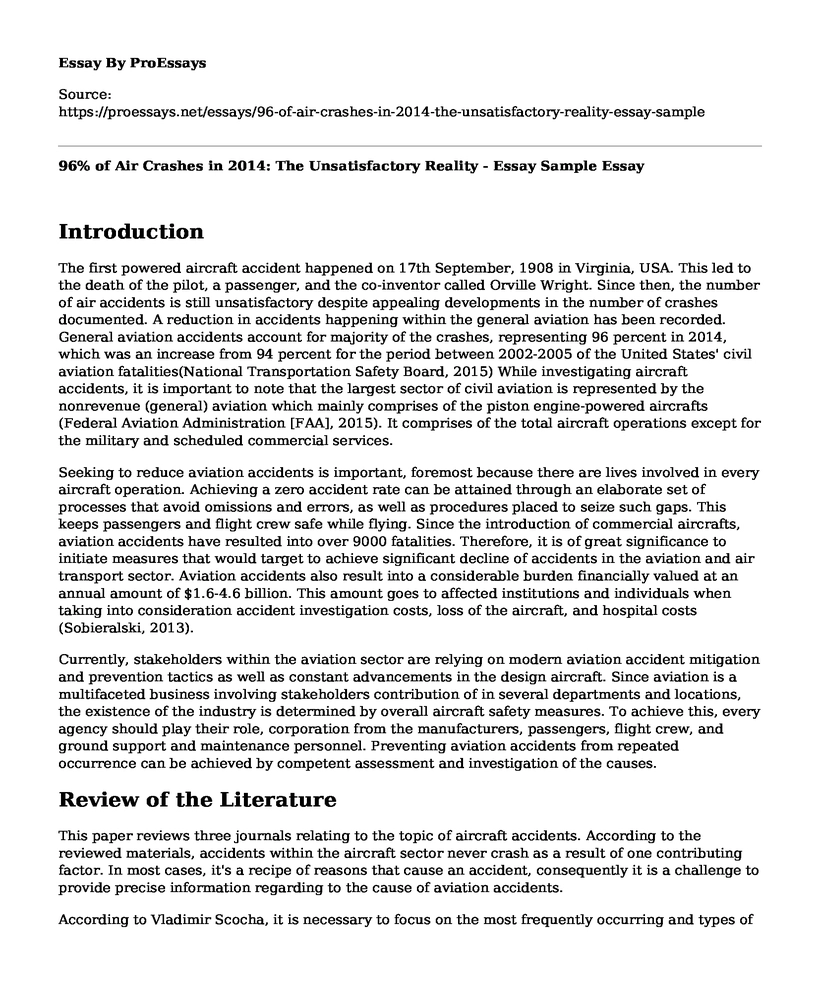Introduction
The first powered aircraft accident happened on 17th September, 1908 in Virginia, USA. This led to the death of the pilot, a passenger, and the co-inventor called Orville Wright. Since then, the number of air accidents is still unsatisfactory despite appealing developments in the number of crashes documented. A reduction in accidents happening within the general aviation has been recorded. General aviation accidents account for majority of the crashes, representing 96 percent in 2014, which was an increase from 94 percent for the period between 2002-2005 of the United States' civil aviation fatalities(National Transportation Safety Board, 2015) While investigating aircraft accidents, it is important to note that the largest sector of civil aviation is represented by the nonrevenue (general) aviation which mainly comprises of the piston engine-powered aircrafts (Federal Aviation Administration [FAA], 2015). It comprises of the total aircraft operations except for the military and scheduled commercial services.
Seeking to reduce aviation accidents is important, foremost because there are lives involved in every aircraft operation. Achieving a zero accident rate can be attained through an elaborate set of processes that avoid omissions and errors, as well as procedures placed to seize such gaps. This keeps passengers and flight crew safe while flying. Since the introduction of commercial aircrafts, aviation accidents have resulted into over 9000 fatalities. Therefore, it is of great significance to initiate measures that would target to achieve significant decline of accidents in the aviation and air transport sector. Aviation accidents also result into a considerable burden financially valued at an annual amount of $1.6-4.6 billion. This amount goes to affected institutions and individuals when taking into consideration accident investigation costs, loss of the aircraft, and hospital costs (Sobieralski, 2013).
Currently, stakeholders within the aviation sector are relying on modern aviation accident mitigation and prevention tactics as well as constant advancements in the design aircraft. Since aviation is a multifaceted business involving stakeholders contribution of in several departments and locations, the existence of the industry is determined by overall aircraft safety measures. To achieve this, every agency should play their role, corporation from the manufacturers, passengers, flight crew, and ground support and maintenance personnel. Preventing aviation accidents from repeated occurrence can be achieved by competent assessment and investigation of the causes.
Review of the Literature
This paper reviews three journals relating to the topic of aircraft accidents. According to the reviewed materials, accidents within the aircraft sector never crash as a result of one contributing factor. In most cases, it's a recipe of reasons that cause an accident, consequently it is a challenge to provide precise information regarding to the cause of aviation accidents.
According to Vladimir Scocha, it is necessary to focus on the most frequently occurring and types of air accidents, such as the CFIT and loss of control over the aircraft so as to achieve a substantial progress in air transportation safety. Causes affecting the accident rate in air transportation can classified from various factors and points of view. The most general and probably the most transparent way of classification is dependence on human action or failure, technical and meteorological factors.
In the light of the development of aviation technical systems, the occurrence of air accidents caused by aviation technology is reducing. However the share of human factor on air accidents is increasing. Currently, human factors are the highest cause of aircraft accidents, contributing to about 80 %. Another category of serious air accidents is made up of the Controlled Flight
Into Terrain (CFIT). The CFIT involves accidents at which the aircaft is flying on a final approach course for landing at poor visibility or when flying in clouds, or even by night. It is important to point out that at air accidents are not only monitored in terms of their direct causes, but also in terms of the phase of flight when they occur.It has been found out that as much as 50 % of all the accidents took place during the approach to landing, which represents only 4 % of the total flight time. Another 27 % of accidents occured during takeoffs and initial climbs representing only some 2 % of the flight time.
Measure to prevent accident rate from increasing are developed by operators as a result of an analysis focused on activities and causes of them. Prevention should primarily focus on training and education of the aircrew, care for the aviation equipment, technical support to air traffic, organizational and control issues as well as the field of care for the labor force.
Determining of the causes of air accidents and preventing them from occurrence is an important part of the flight safety system.
Cite this page
96% of Air Crashes in 2014: The Unsatisfactory Reality - Essay Sample. (2023, May 23). Retrieved from https://proessays.net/essays/96-of-air-crashes-in-2014-the-unsatisfactory-reality-essay-sample
If you are the original author of this essay and no longer wish to have it published on the ProEssays website, please click below to request its removal:
- Essay Example on TSA: Created After 9/11 to Secure Airline Borders
- Airline Business: Changes in the Global Environment Since 2017 - Essay Sample
- Lean Ops in Aviation: Improving Customer Experience & Maximizing Cost - Essay Sample
- 96% of Air Crashes in 2014: The Unsatisfactory Reality - Essay Sample
- Essay Sample on Airport Manager's Communication Strategies for Crisis Management
- Overcome Fear of Flying - One in Three Americans Affected - Essay Sample
- Leaders and Exercising Ethical Influence: A Critical Analysis







